The Impact of an Ultrasonic Field on the Efficiency of Coke Wastewater Treatment in a Sequencing Batch Reactor
Abstract
:1. Introduction
2. Materials and Methods
2.1. Materials
2.2. Experimental Design
2.3. Sonicated
- N—acoustic power (W)
- Es—sonication energy (J)
- ts—sonication time (s)
- I—acoustic wave intensity (W)
- S—area of the surface that the wave passes through (cm2)
2.4. Operating Conditions of Laboratory-Scale SBRs
2.5. Analytical Methods and Statistical Procedures
- Total organic carbon (TOC), total carbon (TC), inorganic carbon (NC), and total nitrogen (TN) were determined using a TOC 10 C Analyzer PX by Kiper, with an AS 40 autosampler by Dione;
- Ammoniacal nitrogen (N-NH4) was determined using the titration method according to standard methods (APHA, 1999) [46];
- pH was determined using the potentiometric method, (pH measurements were conducted using a 59002-00 pH meter by ColePalmer);
2.6. Statistical Analysis
3. Results and Discussion
3.1. Ultrasound of Coke Wastewater—Selection of Amplitude and Sonication Time
3.2. Wastewater Treatment in the SBR
4. Conclusions
Author Contributions
Funding
Institutional Review Board Statement
Informed Consent Statement
Data Availability Statement
Conflicts of Interest
References
- Valia, H.S. Coke Production for Blask Furnace Ironmaking. American Iron and Steel Institute. Available online: http://www.steel.org/making-steel/how-its-made/processes/processes-info/coke-production-for-blastfurnace-ironmak-ing.aspx (accessed on 11 January 2021).
- Metallurgical Coke Market Outlook. CRU. 2015. Available online: https://www.crugroup.com/analysis/coal/ (accessed on 11 January 2021).
- Research Report on China’s Coke Industry 2010–2019. Research and Market. Available online: http://www.researchandmarkets.com/research/6998gk/research_report (accessed on 11 January 2021).
- Żarczyński, P.; Sikorski, C.; Strugała, A. Defining strategic directions of technological development coking plants in Poland based on the forecast of the raw material base and the expectations of coke customers. Energy Policy 2012, 15, 269–283. Available online: https://meeri.eu/Wydawnictwa/PE154/4-20-zarczynski-i-in.pdf.
- Li, Y.; Gu, G.; Zhao, J.; Yu, H.-Q.; Qiu, Y.; Peng, Y. Treatment of coke-plant wastewater by biofilm systems for removal of organic compounds and nitrogen. Chemosphere 2003, 52, 997–1005. [Google Scholar] [CrossRef]
- Staib, C. Understanding and Modelling the Dynamics of Aerobic Biodegradation of Coke-Oven Wastewater. Ph.D. Thesis, University of Queensland, Brisbane, Australia, 1998. [Google Scholar]
- Vázquez, I.; Rodríguez, J.; Marañón, E.; Castrillón, L.; Fernández, Y. Simultaneous removal of phenol, ammonium and thiocyanate from coke wastewater by aerobic biodegradation. J. Hazard. Mater. 2006, 137, 1773–1780. [Google Scholar] [CrossRef] [PubMed]
- Vázquez, I.; Rodriguez, J.; Maranon, E.; Castrillón, L.; Fernández-Nava, Y. Study of the aerobic biodegradation of coke wastewater in a two and three-step activated sludge process. J. Hazard. Mater. 2006, 137, 1681–1688. [Google Scholar] [CrossRef] [Green Version]
- Ghose, M. Complete physico-chemical treatment for coke plant effluents. Water Res. 2002, 36, 1127–1134. [Google Scholar] [CrossRef]
- Fan, Y.; Wang, R.; Sun, J.; Xiang, J.; Wang, R.; Sun, H. An effective recycle way of waste coke ash and coking wastewater for preparing coke ash coking wastewater slurry. Sci. Total Environ. 2020, 742, 140581. [Google Scholar] [CrossRef]
- Raper, E.; Stephenson, T.; Simões, F.; Fisher, R.; Anderson, D.; Soares, A. Enhancing the removal of pollutants from coke wastewater by bioaugmentation: A scoping study. J. Chem. Technol. Biotechnol. 2018, 93, 2535–2543. [Google Scholar] [CrossRef] [Green Version]
- Wang, R.; Ma, Q.; Zhao, Z.; Ye, X.; Jin, Q.; Zhao, Z.; Liu, J. Adsorption of Surfactants on Coal Surfaces in the Coking Wastewater Environment: Kinetics and Effects on the Slurrying Properties of Coking Wastewater–Coal Slurry. Ind. Eng. Chem. Res. 2019, 58, 12825–12834. [Google Scholar] [CrossRef]
- Geng, Y.; Bai, J.; Liu, Y.; Zhong, X.; Li, C.; Zhang, Z.; Zhang, Y. Catalysis and degradation of phenol in coking wastewater during low-rank coal coke gasification. React. Chem. Eng. 2020, 1–14. [Google Scholar] [CrossRef]
- Villaverde, S.; García, E.M.L.; Fernández-Polanco, F. New operational strategy for SBR technology for total nitrogen removal from industrial wastewaters highly loaded with nitrogen. Water Sci. Technol. 2000, 41, 85–93. [Google Scholar] [CrossRef]
- Yalmaz, G.; Öztürk, I. Biological ammonia removal from anaerobically pre-treated landfill leachate in sequencing batch reactors (SBR). Water Sci. Technol. 2001, 43, 307–314. [Google Scholar] [CrossRef]
- Wisaam, S.; Wei, Q.W. Review on Sequencing Batch Reactors, Pakistan. J. Nutr. 2007, 6, 11–19. [Google Scholar]
- Marañón, E.; Vázquez, I.; Rodríguez, J.; Castrillón, L.; Fernández, Y.; López, H. Treatment of coke wastewater in a sequential batch reactor (SBR) at pilot plant scale. Bioresour. Technol. 2008, 99, 4192–4198. [Google Scholar] [CrossRef]
- Krzywicka, A.; Kwarciak-Kozłowska, A. Advanced oxidation processes with coke plant wastewater treatment. Water Sci. Technol. 2014, 69, 1875–1878. [Google Scholar] [CrossRef]
- Kwarciak-Kozłowska, A.; Krzywicka, A.; Gałwa-Widera, M. Fenton process supported with ultrasonic field in coke wastewater treatment. Chem. Ind. 2016, 94, 1527–1529. [Google Scholar]
- Richards, W.T.; Loomis, A.L. The chemical effects of high frequency sound waves I. A preliminary survey. J. Am. Chem. Soc. 1927, 49, 3086–3100. [Google Scholar] [CrossRef]
- Kwarciak-Kozłowska, A.; Krzywicka, A. Effect of ultrasonic field to increase the biodegradability of coke processing wastewater. Arch. Waste Manag. Environ. Prot. 2015, 17, 133–142. [Google Scholar]
- Zhang, M.; Zhang, Z.; Liu, S.; Peng, Y.; Chen, J.; Ki, S.Y. Ultrasound-assisted electrochemical treatment for phenolic wastewater. Ultrason. Sonochemistry 2020, 65, 105058. [Google Scholar] [CrossRef] [PubMed]
- Dębowski, M.; Zieliński, M.; Kisielewska, M.; Kazimierowicz, J. Evaluation of Anaerobic Digestion of Dairy Wastewater in an Innovative Multi-Section Horizontal Flow Reactor. Energies 2020, 13, 2392. [Google Scholar] [CrossRef]
- Stępniak, L. The Use of an Ultrasonic Field to Support the Coagulation Process in Water Treatment; Monograph 112—Publishing House of the Częstochowa University of Technology: Czestochowa, Poland, 2005. [Google Scholar]
- Patel, V.K.; Sen, D.J.; Patel, H.U.; Patel, C.N. ChemInform Abstract: Sonochemistry: The Effect of Sonic Waves on Chemical Systems. ChemInform 2011, 42, 573–580. [Google Scholar] [CrossRef]
- Khanal, S.K.; Grewell, D.; Sung, S.; van Leeuwen, J. Ultrasound Applications in Wastewater Sludge Pretreatment: A Review. Crit. Rev. Environ. Sci. Technol. 2007, 37, 277–313. [Google Scholar] [CrossRef]
- Adewuyi, Y.G. Sonochemistry: Environmental Science and Engineering Applications. Ind. Eng. Chem. Res. 2001, 40, 4681–4715. [Google Scholar] [CrossRef]
- Tiehm, A.; Nickel, K.; Zellhorn, M.M.; Neis, U. Ultrasound waste activated sludge disintegration for improving anaerobic stabilization. Water Res. 2001, 35, 2003–2009. [Google Scholar] [CrossRef]
- Doosti, M.R.; Kargar, R.; Sayadi, M.H. Water treatment using ultrasonic assistance: A review. Proc. Int. Acad. Ecol. Environ. Sci. 2012, 2, 96–110. [Google Scholar]
- Borea, L.; Naddeo, V.; Shalaby, S.M.; Zarra, T.; Belgiorno, V.; Abdalla, H.; Shaban, A.M. Wastewater treatment by membrane ultrafiltration enhanced with ultrasound: Effect of membrane flux and ultrasonic frecuency. Ultrasonics 2017, 83, 42–47. [Google Scholar] [CrossRef] [PubMed]
- Changxiu, G.; Jianguo, J.; Deán, L. Ultrasound coupled with Fenton oxidation pretreatment of sludge to release organic carbon, nitrogen and phosphorus. Sci. Total Environ. 2015, 532, 495–500. [Google Scholar]
- Vázquez-López, M.; Amabilis-Sosa, L.E.; Moeller-Chávez, G.E.; Roé-Sosa, A.; Neumann, P.; Vidal, G. Evaluation of the ultrasound effect on treated municipal wastewater. Environ. Technol. 2018, 40, 3568–3577. [Google Scholar] [CrossRef]
- Suscha, J.; Grűbel, K.; Machnicka, A. Possibility to intensify the process of anaerobic digestion of sewage sludge by disintegrating the activated sludge in the process of mechanical cavitation. Gas Water Sanit. Technol. 2007, 3, 26–28. [Google Scholar]
- Gogate, P.R. Cavitation: An auxiliary technique in wastewater treatment schemes. Adv. Environ. Res. 2002, 6, 335–358. [Google Scholar] [CrossRef]
- Wolny, L.; Kamzela, T. Ultrasonic disintegration techniques in wastewater and sewage sludge technology. Ecol. Technol. 2003, 11, 3–7. [Google Scholar]
- Mamvura, T.A.; Iyuke, S.E.; Paterson, A.E. Energy changes during use of high-power ultrasound on food grade surfaces. South Afr. J. Chem. Eng. 2018, 25, 62–73. [Google Scholar] [CrossRef]
- Esfahani, M.R.; Azin, M. Pretreatment of sugarcane bagasse by ultrasound energy and dilute acid. Asia-Pacific J. Chem. Eng. 2011, 7, 274–278. [Google Scholar] [CrossRef]
- Worwąg, M.; Grosser, A.; Neczaj, E.; Kamizela, T. Impact of Ultrasonic Pretreatment on the Anaerobic Fermentation of Dairy Waste Activated Sludge. Annu. Set Environ. Prot. 2018, 20, 512–527. [Google Scholar]
- Ingole, N.W.; Khedkar, S.V. The ultrasound reactor technology-a technology for future. IJAERS 2012, 2, 72–75. [Google Scholar]
- Gedanken, A. Ultrasonic Processing to Produce Nanoparticles. In Encyclopedia of Materials: Science and Technology, 2nd ed.; Jürgen, B.K.H., Cahn, R.W., Flemings, M.C., Ilschner, B., Kramer, E.J., Mahajan, S., Eds.; Elsevier Ltd.: London, UK, 2001; pp. 9450–9456. [Google Scholar]
- Kootenaei, F.G.; Mehrdadi, N.; Rezazadeh, M.; Seyedmahalleh, E.S. Application of ultrasound waves for biodegradation of pollutants in wastewater and sludge dewatering. Interciencia 2015, 9, 6–9. [Google Scholar]
- Worwąg, M. Effect of sewage sludge sonication parameters on the content of organic compounds in the supernatant liquid. Desalination Water Treat. 2020, 199, 66–71. [Google Scholar] [CrossRef]
- Upadhyay, K.; Khandate, G. Ultrasound Assisted Oxidation Process for the Removal of Aromatic Contamination from Effluents: A Review. Univers. J. Environ. Res. Technol. 2012, 2, 458–464. [Google Scholar]
- Wydawnictwa Normalizacyjne. PN72/C-0455009, Determination of the efficiency of biochemical anionic oxidation and non-ionic synthetic surfactants by the activated sludge method under kinetic conditions; Wydawnictwa Normalizacyjne: Warszawa, Poland, 1972. (In Polish) [Google Scholar]
- Kamizela, T. The Use of Sonification for Phase Separation in the Thickening of Activated Sludge Suspensions. Monograph of the Częstochowa University of Technology No. 243; Częstochowa University of Technology: Czestochowa, Poland, 2012. [Google Scholar]
- APHA. Standard Methods for the Examination of Water and Wastewater, 20th ed.; American Public Health Association: Washington, DC, USA, 1999. [Google Scholar]
- Kidak, R.; Wilhelm, A.-M.; Delmas, H. Effect of process parameters on the energy requirement in ultrasonical treatment of waste sludge. Chem. Eng. Process. Process. Intensif. 2009, 48, 1346–1352. [Google Scholar] [CrossRef] [Green Version]
- Nanzai, B.; Okitsu, K.; Takenaka, N.; Bandow, H.; Tajima, N.; Maeda, Y. Effect of reaction vessel diameter on sonochemical efficiency and cavitation dynamics. Ultrason. Sonochemistry 2009, 16, 163–168. [Google Scholar] [CrossRef]
- Śliwiński, A. Ultrasound and Its Application; Scientific and Technical Publishing House: Warsaw, Poland, 1993. [Google Scholar]
- Ning, P.; Bart, H.-J.; Jiang, Y.; de Haan, A.; Tien, C. Treatment of organic pollutants in coke plant wastewater by the method of ultrasonic irradiation, catalytic oxidation and activated sludge. Sep. Purif. Technol. 2005, 41, 133–139. [Google Scholar] [CrossRef]
- Xu, J.; Jia, J.; Wang, J. Ultrasonic Decomposition of Ammonia-Nitrogen and Organic Compounds in Coke Plant Wastewater. J. Chin. Chem. Soc. 2005, 52, 59–65. [Google Scholar] [CrossRef]
- Kwarciak-Kozłowska, A.; Sławik-Dembiczak, L. Characterization of the Organic Fraction of Pretreated Leachate from Old Landfill after Sonication Exposure. Eng. Prot. Environ. 2016, 19, 561–575. [Google Scholar] [CrossRef]
- Keller, J.; Watts, S.; Battye-Smith, W.; Chong, R. Full-scale demonstration of biological nutrient removal in a single tank SBR process. Water Sci. Technol. 2001, 43, 355–362. [Google Scholar] [CrossRef] [PubMed]
- Chakraborty, S.; Veeramani, H. Anaerobic-anoxic-oxic sequential degradation of synthetic wastewaters. Appl. Biochem. Biotechnol. 2002, 102, 443–451. [Google Scholar] [CrossRef]
- Kwarciak-Kozłowska, A.; Krzywicka, A.; Gałwa-Widera, M. The use of ozonation process in coke wastewater treatment. Annu. Set Environ. Prot. 2016, 18, 61–73. [Google Scholar]


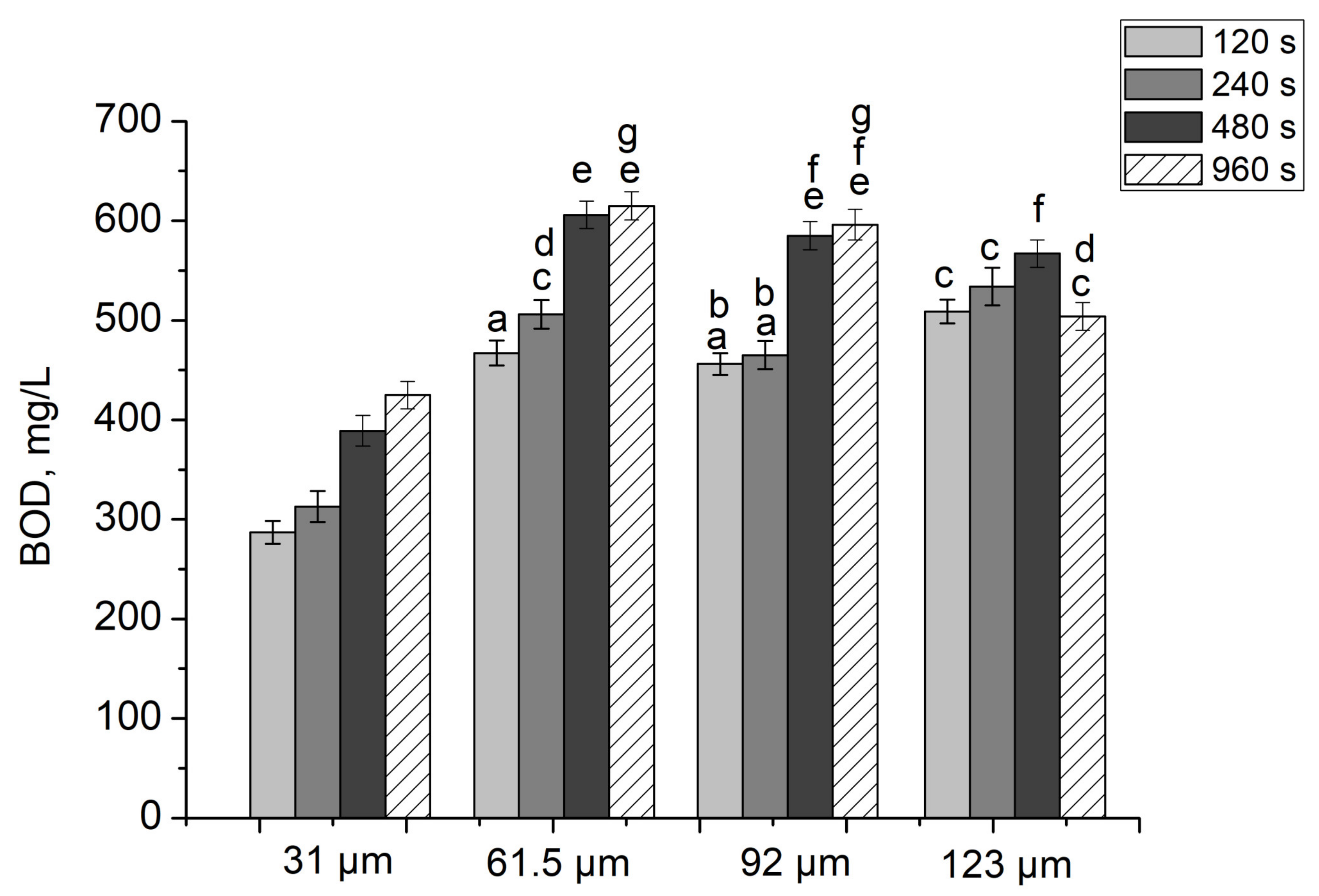
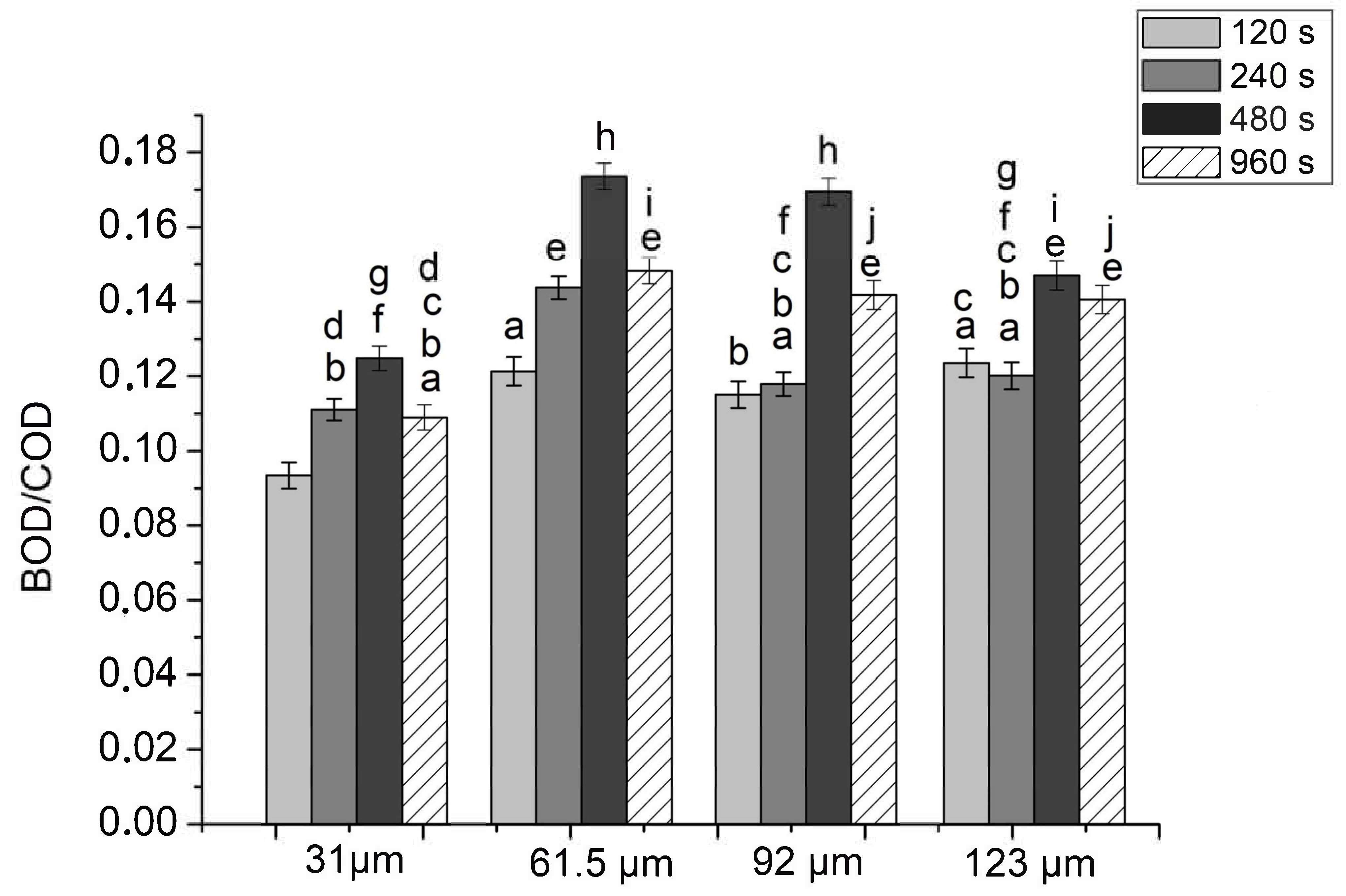
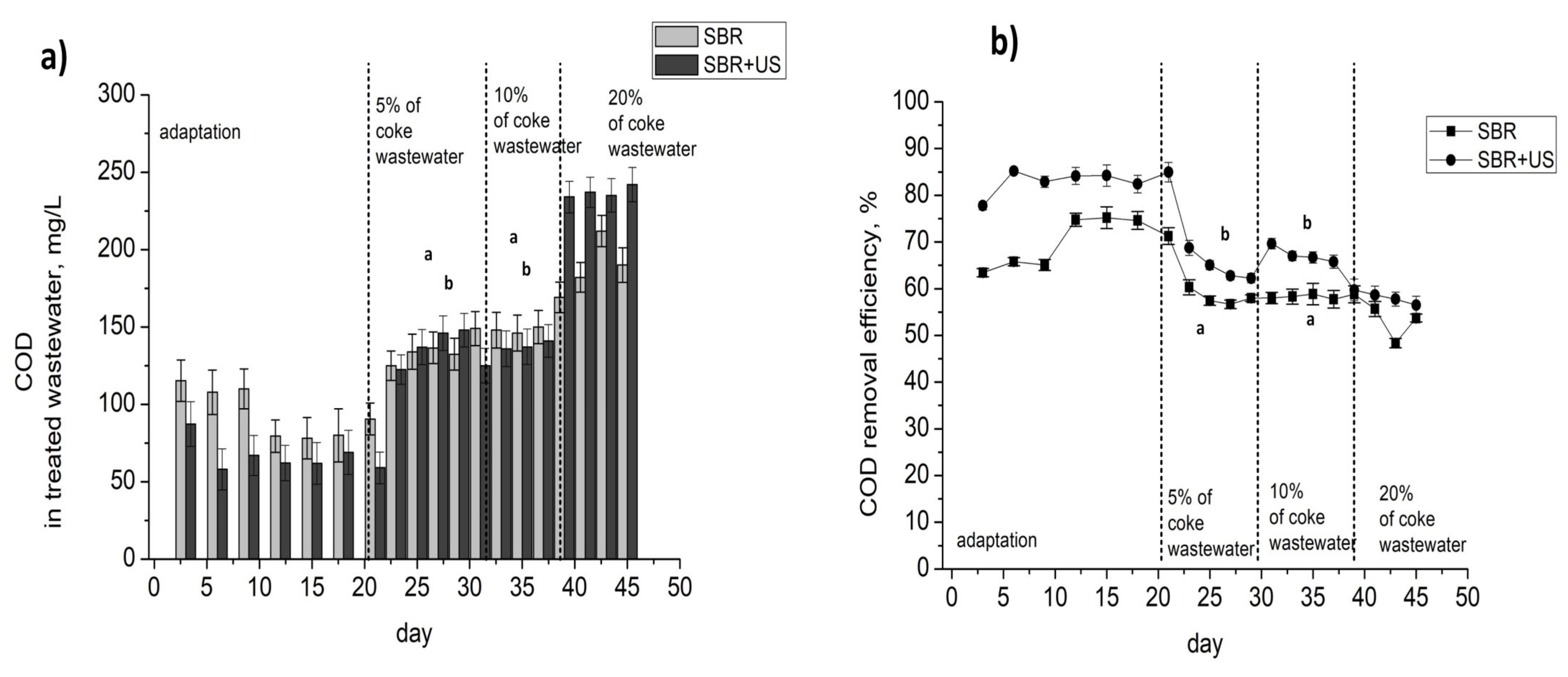

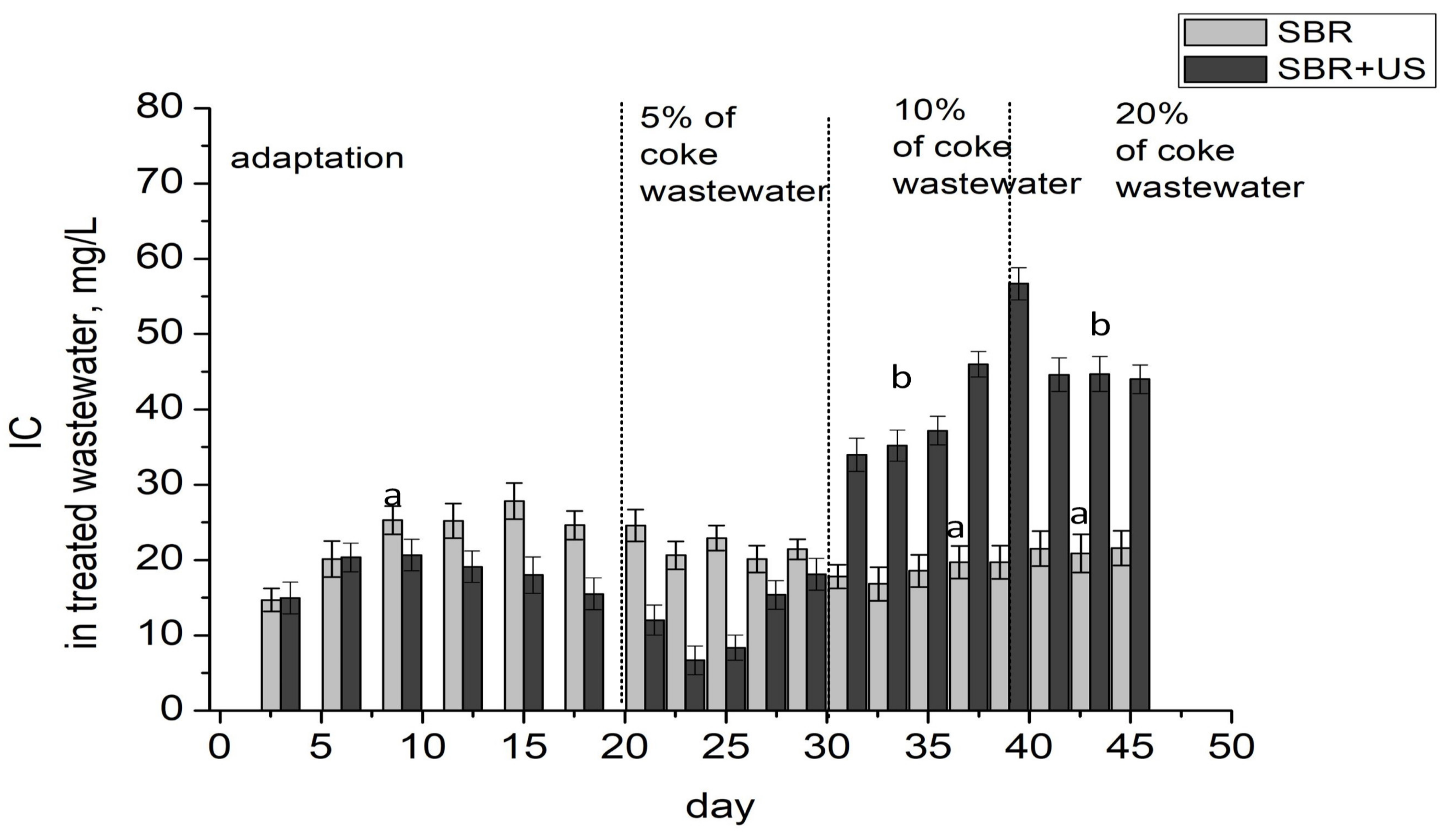
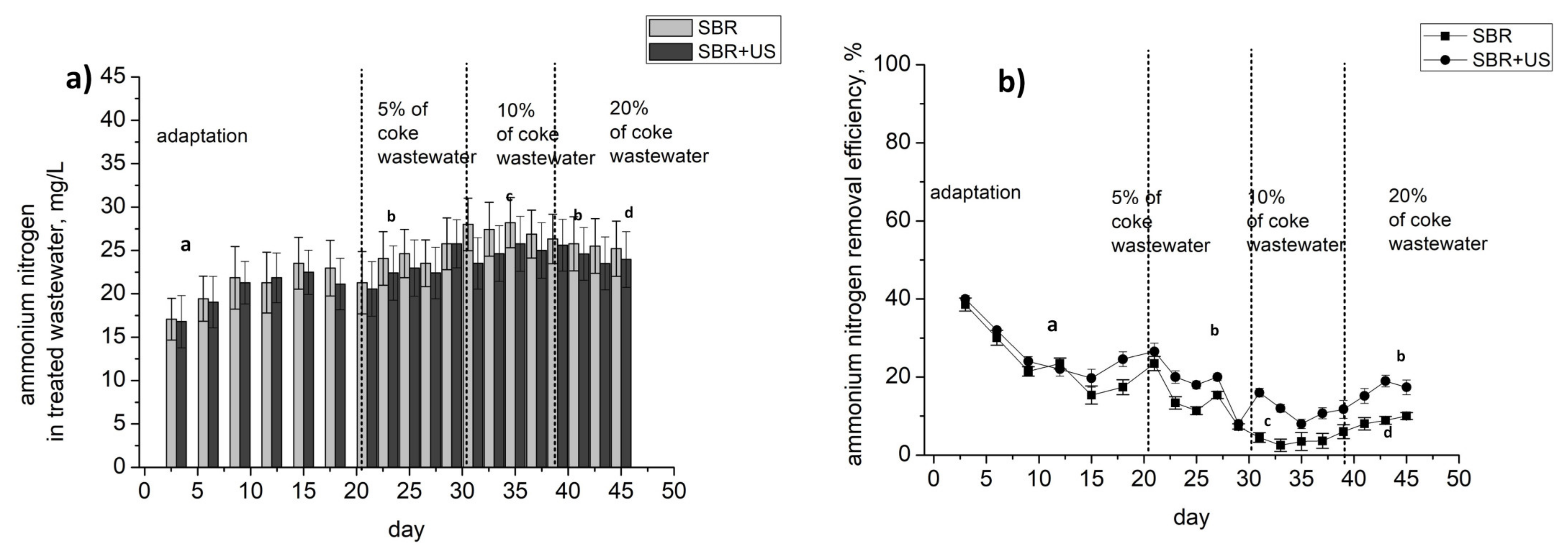

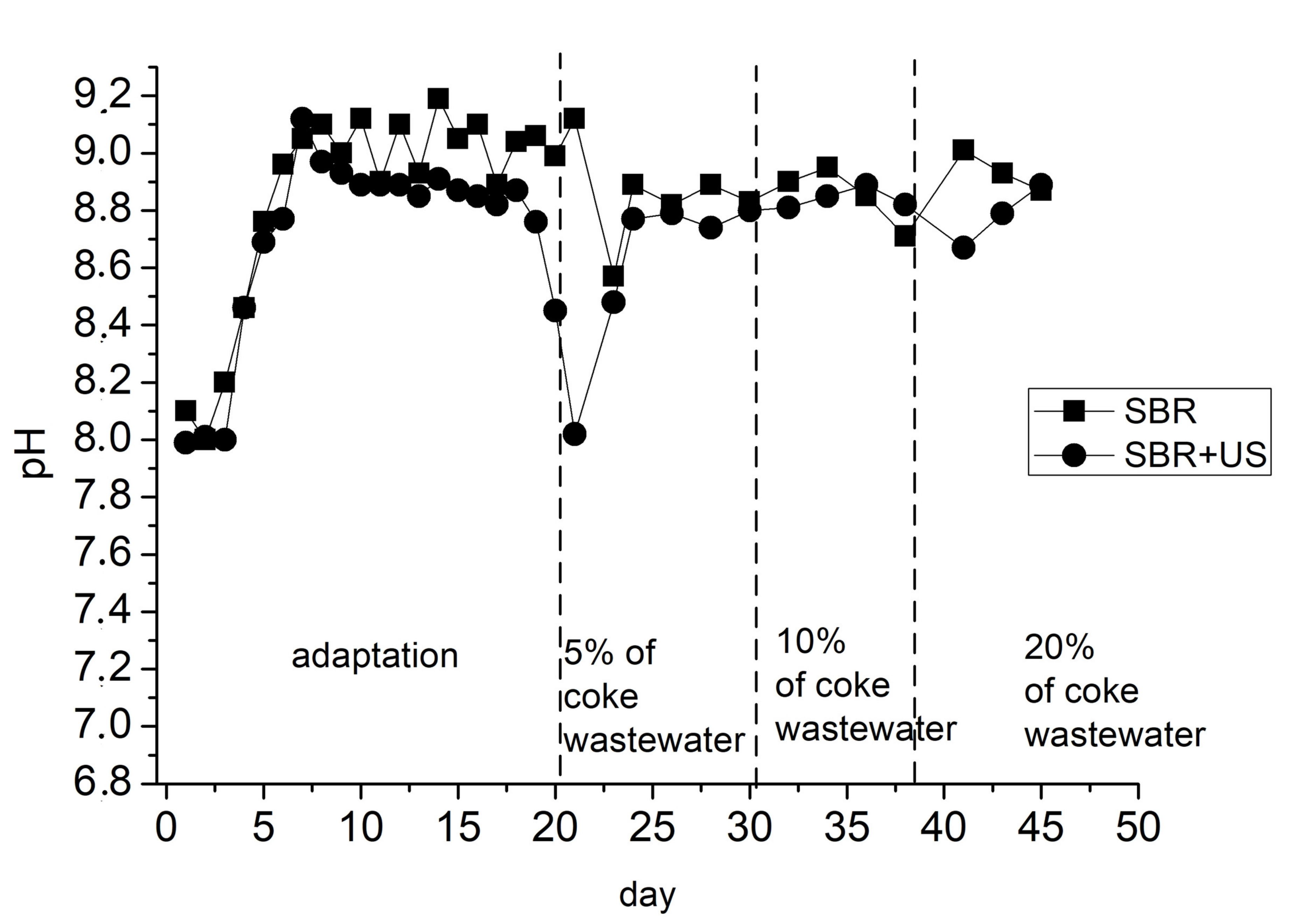
| Pollution Indicator | Unit | Coke Wastewater (CW) | Synthetic Wastewater (SW) | Permissible Pollutant Values in Wastewater Discharged to a Consumer |
|---|---|---|---|---|
| pH | - | 8.79–9.18 | 7.4 | 6.5–9 |
| COD | mg O2/L | 2450–2560 | 380–395 | 250 |
| TOC | mg C/L | 908–935 | 228–248 | 30 |
| IC | mg C/L | 230–245 | 68.4–72.5 | - |
| TN | mg N/L | 1600–1670 | 39.8–42.5 | 3 |
| BOD5 | mg O2/L | 225–235 | 296–298 | 180 |
| BOD5/COD | - | 0.096 | 0.78 | - |
| UD Amplitude | t = 120 s | t = 240 s | t = 480 s | t = 960 s |
|---|---|---|---|---|
| A = 31.0 μm | Es = 4410 J | Es = 9500 J | Es = 12470 J | Es = 28405 J |
| A = 61.5 μm | Es = 7530 J | Es = 20047 J | Es = 31860 J | Es = 43560 J |
| A = 92.0 μm | Es = 10729 J | Es = 40551 J | Es = 82340 J | Es = 91056 J |
| A = 123.0 μm | Es = 25120 J | Es = 109567 J | Es = 117658 J | Es = 120438 J |
| UD Amplitude | t = 120 s | t = 240 s | t = 480 s | t = 960 s |
|---|---|---|---|---|
| A = 31.0 μm | I = 1.09 W/cm2 | I= 1.02 W/cm2 | I = 0.67 W/cm2 | I = 0.76 W/cm2 |
| A = 61.5 μm | I = 1.63 W/cm2 | I = 2.17 W/cm2 | I = 1.72W/cm2 | I = 1.18 W/cm2 |
| A = 92.0 μm | I = 2.32 W/cm2 | I= 4.39 W/cm2 | I = 4.46 W/cm2 | I = 2.46 W/cm2 |
| A = 123.0 μm | I = 5.44 W/cm2 | I= 11.86 W/cm2 | I = 6.37 W/cm2 | I = 3.26 W/cm2 |
| Day | Reactor A | Reactor B |
|---|---|---|
| 1–21 | Adaptation | Adaptation |
| 22–29 | 5% addition of coke wastewater | 5% addition of coke wastewater after US |
| 30–37 | 10% addition of coke wastewater | 10% addition of coke wastewater after US |
| 38–45 | 20% addition of coke wastewater | 20% addition of coke wastewater after US |
| Coke Wastewater Share [%] | Wastewater Charge [gO2/d] | Sludge Loading with Pollution Charge [mgO2/gsmo*d] |
|---|---|---|
| 5 | 0.15 ± 0.01 | 0.032 ± 0.001 |
| 10 | 0.16 ± 0.011 | 0.036 ± 0.001 |
| 20 | 0.205 ± 0.012 | 0.044 ± 0.001 |
| 5US | 0.196 ± 0.03 | 0.042 ± 0.002 |
| 10US | 0.226 ± 0.021 | 0.051 ± 0.001 |
| 20US | 0.2785 ± 0.022 | 0.06 ± 0.001 |
| Parameter | SW + 5% CW | SW + 5% CW-US | SW + 10% CW | SW + 10% CW-US | SW + 20% CW | SW + 20% CW-US |
|---|---|---|---|---|---|---|
| COD | 315 ± 5 | 392 ± 11 | 355 ± 8 | 412 ± 8 | 410.5 ± 11 | 556.5 ± 9.1 |
| TOC | 42.53 ± 1.2 | 43.95 ± 2.1 | 80.53 ± 2.1 | 82.54 ± 2.5 | 179.65 ± 12.1 | 181.9 ± 8.7 |
| IC | 10.48 ± 0.5 | 10.76 ± 0.8 | 19.84 ± 0.78 | 21.2 ± 1.1 | 220.01 ± 14.6 | 223.27 ± 12.5 |
| TN | 83.86 ± 5.4 | 83.61 ± 4.1 | 181.1 ± 11.2 | 198.8 ± 14.4 | 352.4 ± 8.9 | 359 ± 9.4 |
| N-NH4+ | 27.8 ± 1.2 | 28.0 ± 1.1 | 27.9 ± 1.1 | 28.8 ± 3.7 | 28 ± 0.7 | 29.0 ± 1.2 |
| pH | 7.592 ± 0.4 | 7.597 ± 0.4 | 7.67 ± 0.6 | 7.647 ± 0.7 | 7.693 ± 0.8 | 7.697 ± 0.5 |
Publisher’s Note: MDPI stays neutral with regard to jurisdictional claims in published maps and institutional affiliations. |
© 2021 by the authors. Licensee MDPI, Basel, Switzerland. This article is an open access article distributed under the terms and conditions of the Creative Commons Attribution (CC BY) license (http://creativecommons.org/licenses/by/4.0/).
Share and Cite
Kwarciak-Kozłowska, A.; Worwąg, M. The Impact of an Ultrasonic Field on the Efficiency of Coke Wastewater Treatment in a Sequencing Batch Reactor. Energies 2021, 14, 963. https://doi.org/10.3390/en14040963
Kwarciak-Kozłowska A, Worwąg M. The Impact of an Ultrasonic Field on the Efficiency of Coke Wastewater Treatment in a Sequencing Batch Reactor. Energies. 2021; 14(4):963. https://doi.org/10.3390/en14040963
Chicago/Turabian StyleKwarciak-Kozłowska, Anna, and Małgorzata Worwąg. 2021. "The Impact of an Ultrasonic Field on the Efficiency of Coke Wastewater Treatment in a Sequencing Batch Reactor" Energies 14, no. 4: 963. https://doi.org/10.3390/en14040963







